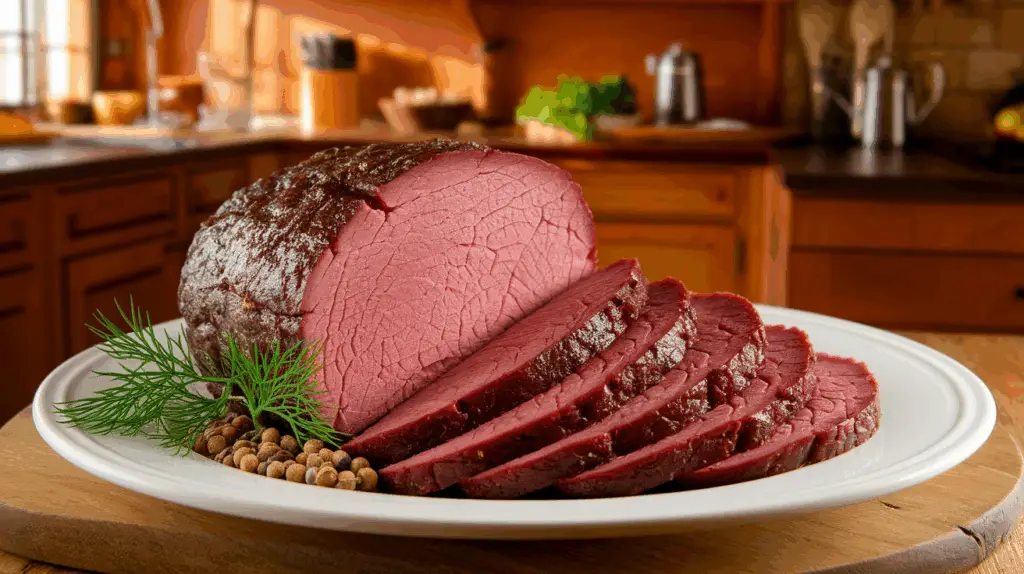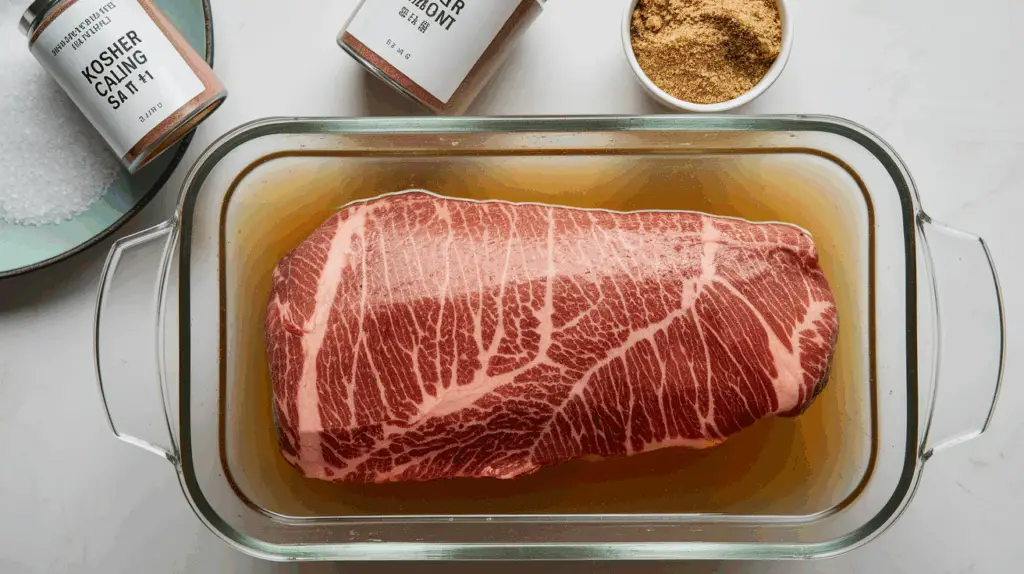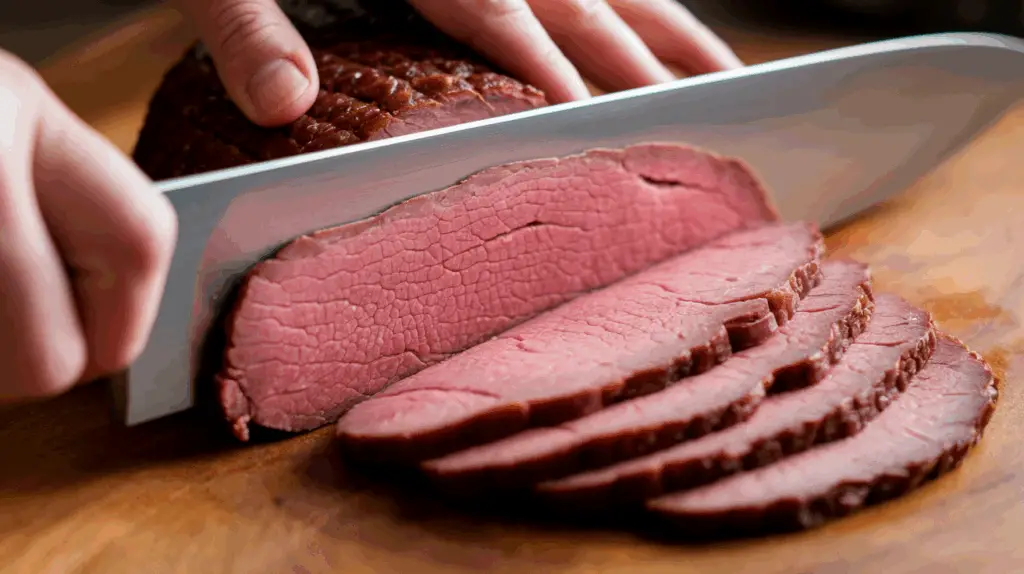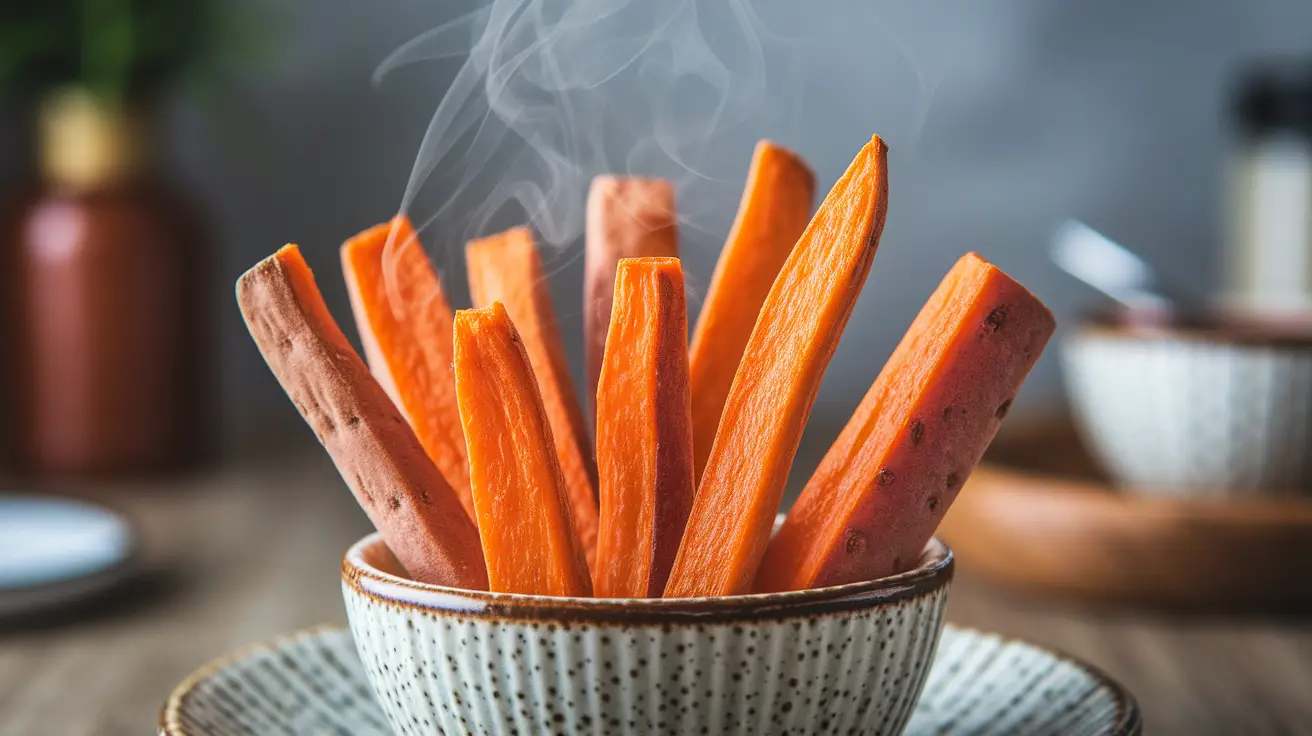Alright, my fellow culinary explorer, let’s talk about corned beef. Just the name conjures images of St. Patrick’s Day feasts, deli sandwiches stacked impossibly high, and that distinct, savory aroma. But have you ever actually thought about how to make corned beef from scratch? If your answer is “Nope, looks way too complicated, I’ll just buy the pre-brined stuff,” then you are not alone! For years, I was right there with you, assuming it was some arcane magic performed only by seasoned butchers or Irish grandmas. My first thought was, “Isn’t it just boiled beef?” Oh, how naive I was! Brining beef sounds intimidating, involves waiting days, and might even make you wonder if you’re doing something illegal with pink salt. Giggle. But trust me, the homemade version? It’s a flavor revelation, incredibly satisfying, and frankly, a badge of honor for any home cook. Let’s unravel the mystery together and get you on your way to corned beef glory!
What Exactly is Corned Beef? Demystifying the Brine
Before we get to cooking, let’s demystify what corned beef actually is. It’s not just regular beef that you boil. “Corning” is an old curing process, where beef (usually brisket) gets submerged in a salty, spiced brine for several days. The “corn” part refers to the large grains of salt (historically, “corns” of salt) used in the curing process.
Here’s the magical bit:
- The Brine: This isn’t just a salty bath. It’s a carefully balanced solution of salt, sugar, water, and crucially, curing salt (Prague Powder #1).
- Curing Salt (Sodium Nitrite): This is the key ingredient that gives corned beef its characteristic pink color (without it, it would turn grayish-brown when cooked), prevents bacterial growth (especially botulism), and contributes to its unique flavor. It is essential for safety and flavor.
- The Transformation: Over days, the brine penetrates the meat, tenderizing it, preserving it, and imparting that distinctive savory, slightly tangy flavor we all know and love. Without the brine, it’s just… boiled beef. And frankly, boiled beef isn’t winning any awards.
Homemade corned beef gives you control over the saltiness and spice level. Plus, the bragging rights are immense. Have you ever served homemade corned beef to guests? Their jaws will drop. IMO, it’s worth the multi-day wait!
The Essential Ingredients for Your Brining Magic
Ready to gather your supplies? You’ll need a few specific things, especially that special salt.
The Beef: Choosing Your Brisket
- Brisket Flat Cut: This is my absolute favorite for corned beef. The flat is the leaner, flatter part of the brisket, perfect for slicing once cooked. You can also use a “point” cut (fattier, more irregular) if you plan on shredding your corned beef. Aim for a 3-5 pound flat cut.
The Salt Situation: Regular vs. Curing Salt (Prague Powder #1)
This is the most important distinction for safety and proper corning.
- Kosher Salt (or Sea Salt): This is your main salt. Use non-iodized salt (iodine can affect color). This provides the primary saltiness.
- Prague Powder #1 (also known as Pink Curing Salt #1 or InstaCure #1): This is critical! It’s a mixture of salt and 6.25% sodium nitrite. It’s what gives corned beef its color and prevents bacterial growth. It is NOT regular pink Himalayan salt. Use precisely the amount specified in your recipe, as too much can be harmful. You can buy it online or at specialty butcher shops. A little goes a long way.
Flavor Boosters: Pickling Spices
These are the aromatic backbone of corned beef. You can buy pre-made pickling spice blends, or make your own!
- Common Pickling Spices: Mustard seeds, coriander seeds, peppercorns, bay leaves, allspice berries, cloves, ginger, red pepper flakes, cinnamon sticks, dill seed, star anise.
Liquid and Sweetness
- Water: Plain old tap water works, but ensure it’s cold.
- Brown Sugar (or Granulated Sugar): A touch of sugar balances the saltiness and aids in the curing process, contributing to tenderness.
Basic Brine Components (per gallon of water, for approx. 3-5 lbs beef):
- 1 gallon cold water
- 1 cup kosher salt
- 1/2 cup packed brown sugar
- 4 teaspoons Prague Powder #1 (MUST BE PRECISE!)
- 2 tablespoons pickling spices (or your homemade blend)
- Optional aromatics: 4-5 cloves garlic (smashed), 1 sliced onion.
Equipment for the Brine & Beyond: You’ve Got This!
You don’t need a lab, just a few kitchen essentials.
- Large Non-Reactive Container: This is crucial. Use a food-grade plastic container, a large glass bowl, or a ceramic crock. Do NOT use reactive metals like aluminum, which can react with the brine.
- Weight: Something heavy to keep the beef fully submerged in the brine. A plate weighted down by a jar or a ziploc bag filled with water works well.
- Large Pot/Dutch Oven/Slow Cooker/Instant Pot: For cooking the brined beef.
Step-by-Step Brining: Patience is Your Best Friend
This is where the magic happens, but it requires patience. Don’t rush this part!
Prepping Your Beef
- Inspect your brisket for any extremely thick fat pockets or silver skin. Trim off any excess hard fat or membrane that won’t render or tenderize. You want a relatively even thickness.
- Pat the brisket dry with paper towels.
Mixing the Brine Solution
- In your large non-reactive container, combine the cold water, kosher salt, brown sugar, Prague Powder #1, and pickling spices (plus any optional aromatics like garlic/onion).
- Stir well until the salt and sugar are completely dissolved. This might take a few minutes. You should have a clear, spiced liquid.
Submerging & Weighing Down
- Carefully place your beef brisket into the brine solution.
- Ensure the brisket is completely submerged. This is vital for proper curing and safety.
- Place your plate or weighted bag on top of the brisket to keep it fully under the brine.
The Waiting Game: Refrigeration & Flipping
- Cover the container and refrigerate it. The brining process takes time.
- Brining Time: For a 3-5 pound brisket, brine for 5 to 7 days. I usually aim for 7 days for maximum flavor and tenderness.
- Flip Daily: Every day or so, give the brisket a flip in the brine to ensure even curing.
- Check Clarity: The brine might get a little cloudy, but it should never smell bad or slimy. If it does, discard it and your beef. (This is rare if you keep it properly refrigerated).
Cooking Your Homemade Corned Beef: Tender Perfection Awaits
After its long spa treatment in the brine, your beef is “corned” and ready for cooking!
Rinsing & Soaking: A Critical Pre-Cook Step
This is essential to prevent your corned beef from being overly salty.
- Remove the brisket from the brine. Discard the brine.
- Rinse the brisket thoroughly under cold running water to remove any surface salt or spices.
- For about 1-2 hours, soak the brisket in fresh cold water, changing the water once or twice. This further draws out excess salt, ensuring it’s perfectly seasoned. Skipping this step makes it too salty, trust me, I’ve made that mistake before!
Method 1: Stove Top Simmer (Classic & Reliable)
This is the traditional way to cook corned beef.
- Place the rinsed and soaked corned beef in a large pot or Dutch oven.
- Cover the beef completely with fresh cold water (or beef broth for extra flavor). You can add a fresh bay leaf, a few peppercorns, or a pinch of fresh pickling spices at this stage if you like.
- Bring to a boil, then immediately reduce heat to a gentle simmer.
- Cover and simmer for 3-4 hours (for a 3-5 lb brisket), or until it is fork-tender. You should be able to easily push a fork into the meat with little resistance.
- Adding Veggies: If you’re cooking with traditional veggies (cabbage, carrots, potatoes), add them during the last 30-60 minutes of cooking, depending on how tender you like them.
Method 2: Slow Cooker/Crock Pot (Hands-Off & Easy)
Great for busy days!
- Place the rinsed and soaked corned beef in your slow cooker.
- Add enough fresh cold water or beef broth to mostly cover the beef (or follow your slow cooker recipe’s liquid recommendations).
- Cook on Low for 8-10 hours or on High for 4-6 hours, until fork-tender.
- Adding Veggies: Add heartier vegetables like carrots and potatoes during the last 2-3 hours on low, or 1-1.5 hours on high. Add cabbage wedges during the last 30-45 minutes.
Method 3: Instant Pot (Speedy & Efficient)
For when you need corned beef now!
- Place the rinsed and soaked corned beef in your Instant Pot.
- Add 4-6 cups of fresh cold water or beef broth.
- Close the lid and set the valve to sealing. Cook on High Pressure for 90 minutes (1.5 hours) for a 3-4 lb brisket. For a 5 lb brisket, go for 100-110 minutes.
- Allow for a natural pressure release (NPR) for at least 15-20 minutes, then do a quick release of any remaining pressure.
- Adding Veggies: Remove the beef. Add vegetables and cook on High Pressure for 3-5 minutes with a quick release.
Oven Roasting (For a More “Baked” Result)
This method provides a richer flavor and is great for slicing.
- Place the rinsed and soaked corned beef in a large Dutch oven or oven-safe pot.
- Add enough fresh cold water or beef broth to come halfway up the sides of the brisket.
- Add pickling spices (optional). Cover tightly with a lid or foil.
- Bake at 325°F (160°C) for 3-4 hours, or until fork-tender. Check liquid level periodically and add more if needed.
The All-Important Rest: Don’t Skip It!
This step is NON-NEGOTIABLE for juicy, tender corned beef. Seriously, don’t skip it.
- Once your corned beef is cooked to tenderness, remove it from the cooking liquid.
- Place it on a cutting board, loosely tent it with foil, and let it rest for at least 15-30 minutes (or longer for a larger cut). This allows the juices to redistribute throughout the meat, preventing them from running out when you slice.
Slicing Your Masterpiece: Against the Grain for Tenderness
You’ve put in the days (and hours!). Now for the grand finale. Slicing corned beef correctly is crucial for tenderness.
- Identify the Grain: Look closely at the muscle fibers running through the meat. They run in a specific direction.
- Slice Against the Grain: Use a long, sharp slicing knife to slice the corned beef thinly, perpendicular to the grain. Slicing with the grain will result in chewy, tough slices, even if the meat is perfectly tender. The flat cut usually has a consistent grain.
Troubleshooting: When Brining or Cooking Goes Sideways
Even with the best intentions, things can go wrong. It’s a learning process!
- Corned Beef is Too Salty:
- Solution: You didn’t rinse and soak it enough before cooking. Next time, give it a longer soak in fresh cold water, changing the water multiple times.
- Dry Corned Beef:
- Solution: You overcooked it, or you didn’t rest it long enough. Even though it’s “fork-tender,” it can still dry out. Pull it off the heat as soon as it’s tender and give it a good rest.
- Tough Corned Beef:
- Solution: You undercooked it! It needs more time for that connective tissue to break down. Or, you sliced it with the grain. Let it cook until it’s truly fall-apart tender.
- Not Pink/Off-Color:
- Solution: You likely didn’t use Prague Powder #1, or you didn’t use enough. This curing salt is crucial for the color.
Serving Suggestions: Beyond the Reuben!
You’ve made glorious homemade corned beef! Now enjoy it!
- Classic Corned Beef & Cabbage: Serve with boiled potatoes, carrots, and cabbage wedges.
- The Ultimate Reuben: Thinly sliced corned beef on rye bread with Swiss cheese, sauerkraut, and Russian dressing.
- Corned Beef Hash: Dice leftover corned beef and pan-fry with diced potatoes and onions for breakfast.
- Sandwiches & Wraps: Cold slices make incredible sandwiches with mustard or horseradish sauce.
- Soups & Stews: Add diced corned beef to a hearty vegetable soup.
Frequently Asked Questions
- What is the main ingredient in corned beef? The main ingredient in corned beef is beef brisket, which is a cut of beef from the lower chest or breast of a cow.
- How long does it take to cure beef for corned beef? To cure beef for homemade corned beef, it typically needs to brine in a salt and spice solution, including curing salt, for 5 to 7 days in the refrigerator. This process transforms the beef and gives it its characteristic flavor and color.
- What kind of salt do you use to make corned beef? To make corned beef, you use two types of salt: non-iodized kosher salt (or sea salt) as the primary salt, and Prague Powder #1 (pink curing salt #1), which contains sodium nitrite and is essential for safety, color, and flavor.
- Do you rinse corned beef before cooking? Yes, you must rinse and soak corned beef in fresh cold water after brining and before cooking. This crucial step removes excess surface salt, preventing the final cooked product from being overly salty. Soaking for 1-2 hours, changing the water periodically, is recommended.
- How do you know when homemade corned beef is done? Homemade corned beef is done when it is fork-tender. You should be able to easily push a fork into the meat with little resistance. Cooking times vary by method (e.g., 3-4 hours simmering on the stovetop, 8-10 hours in a slow cooker, or 90 minutes in an Instant Pot).
- Can you make corned beef without pink curing salt? No, you should not make traditional corned beef without pink curing salt (Prague Powder #1). This ingredient is critical for food safety (preventing botulism) and for giving corned beef its characteristic pink color and cured flavor. Regular pink Himalayan salt is NOT a substitute.
- How do you slice corned beef to make it tender? To make corned beef tender when slicing, you must slice it against the grain. Identify the direction of the muscle fibers in the meat and cut perpendicular to them with a long, sharp slicing knife. This shortens the muscle fibers, making each bite tender.
Conclusion
So there you have it, my friend! The complete, no-frills guide on how to make corned beef from scratch. It might seem like a long project upfront, but the hands-on time is minimal, and the reward—a tender, flavorful, homemade corned beef that will blow any store-bought version out of the water—is absolutely immense. Embrace the waiting game, understand the science, and get ready to impress everyone with your culinary prowess. Go forth, cure that beef, and enjoy! You’ve totally got this! 🙂





